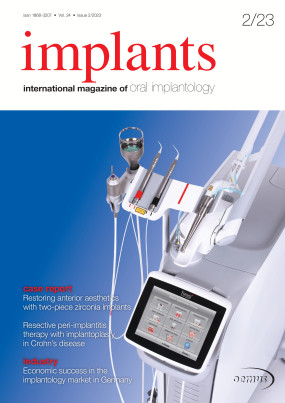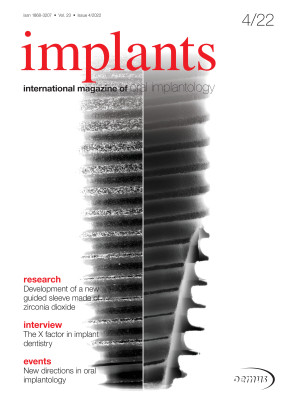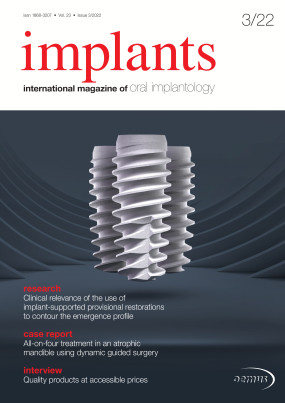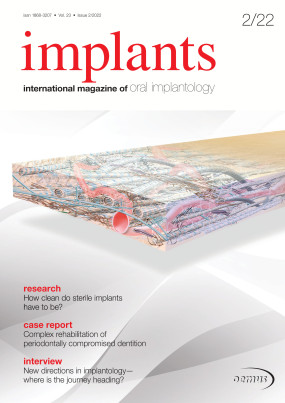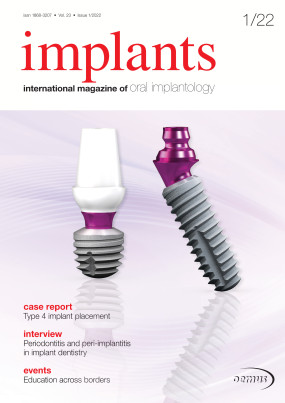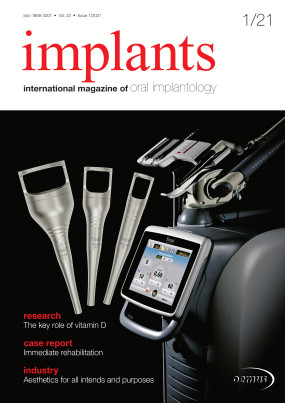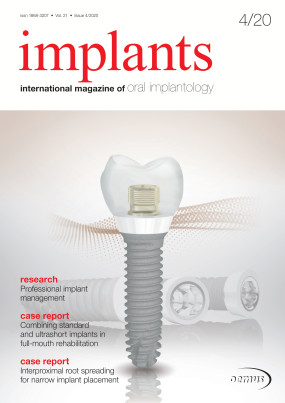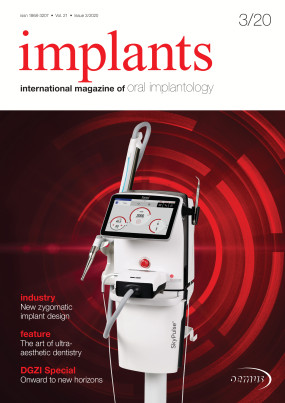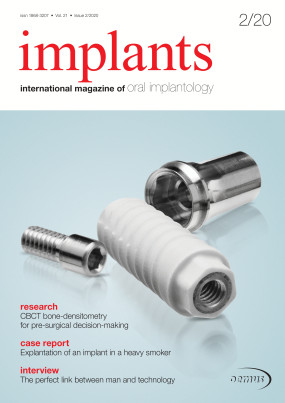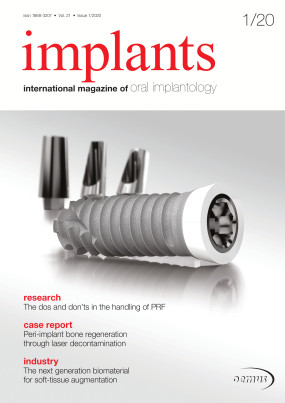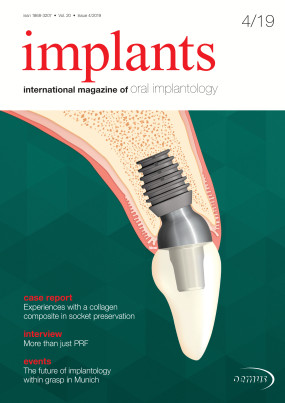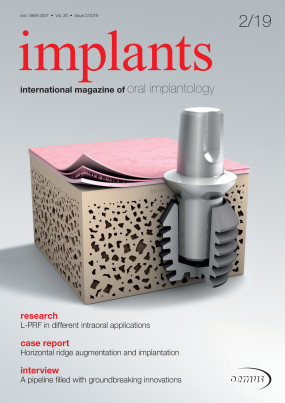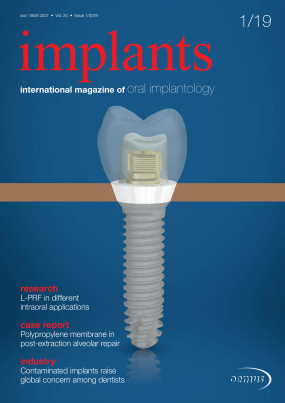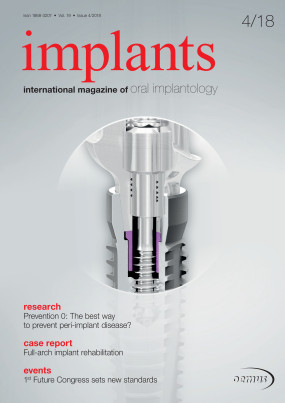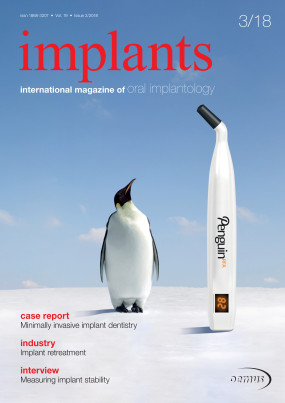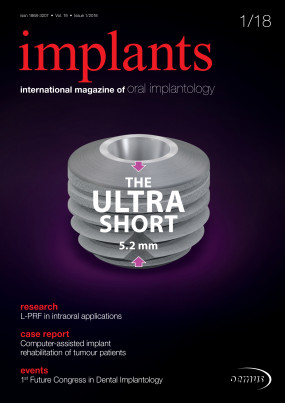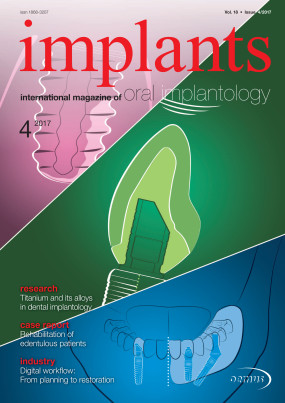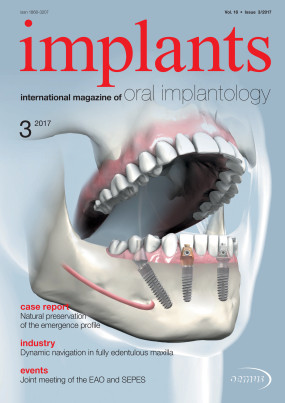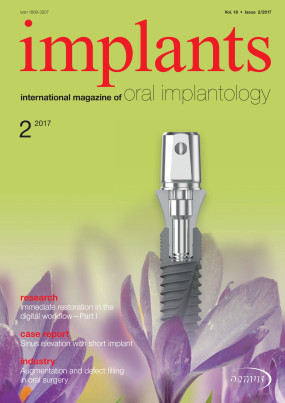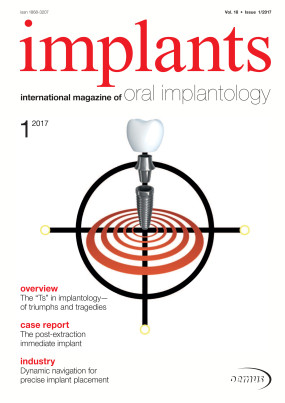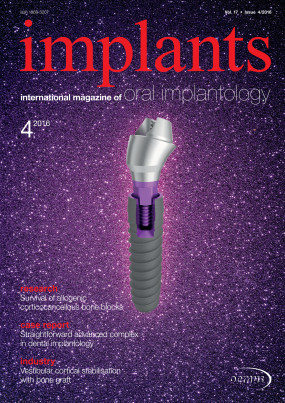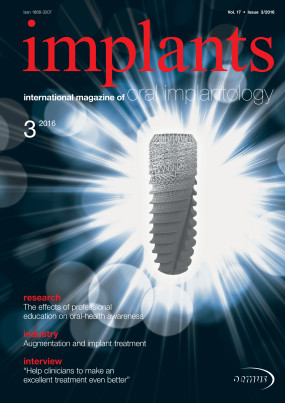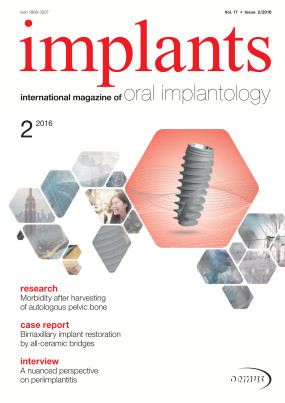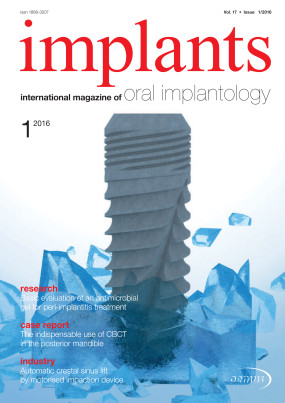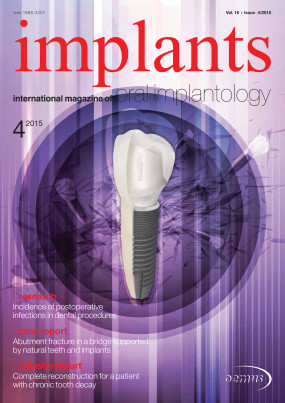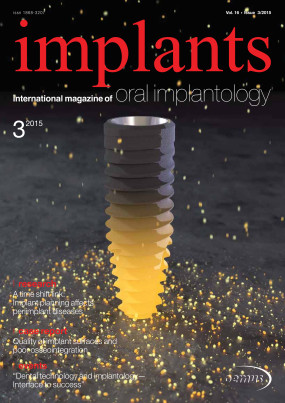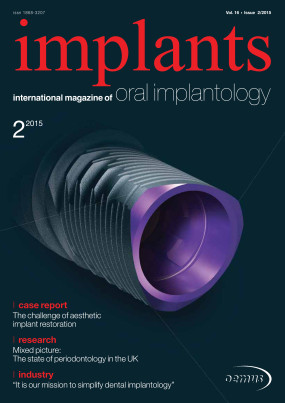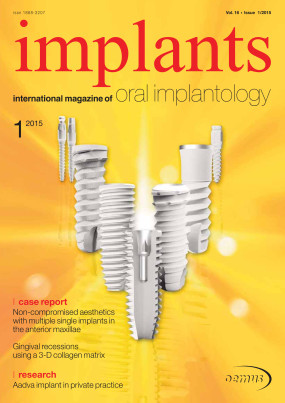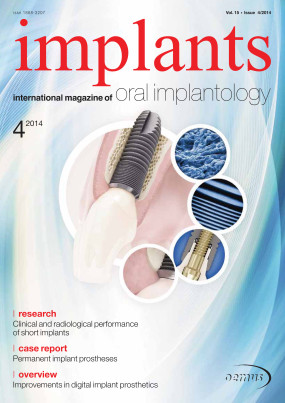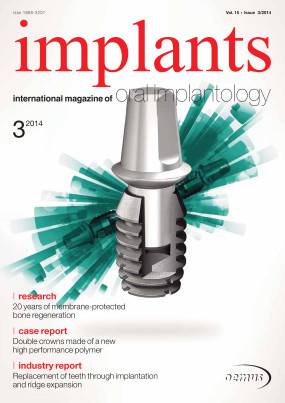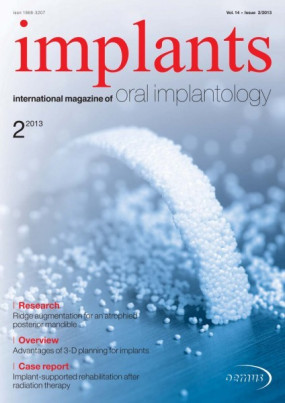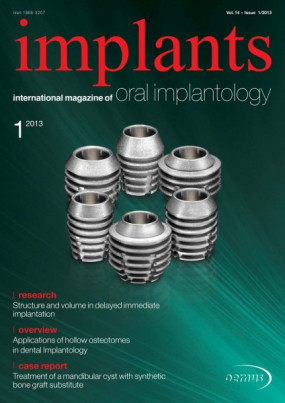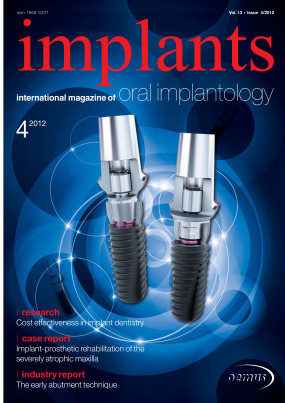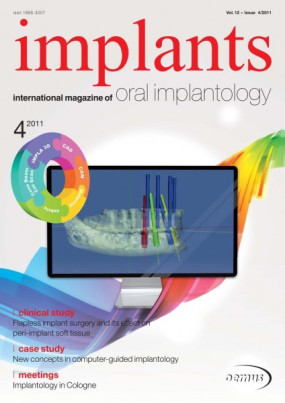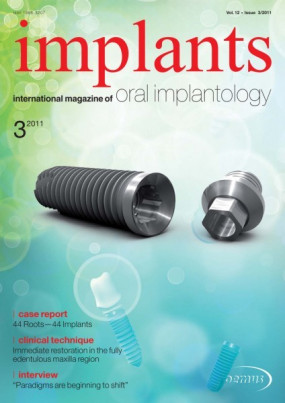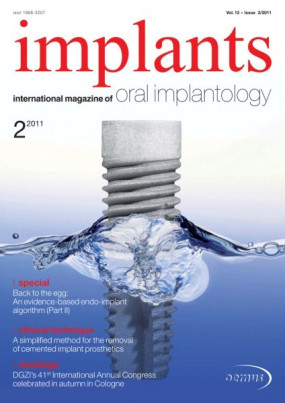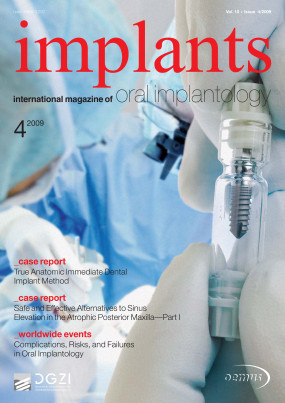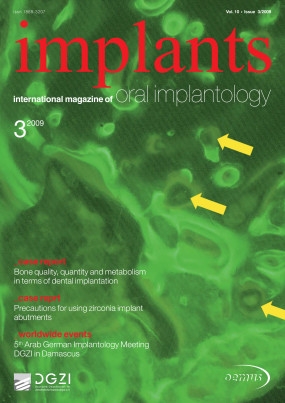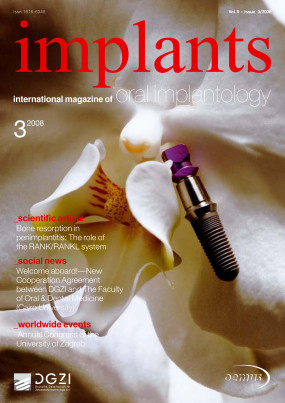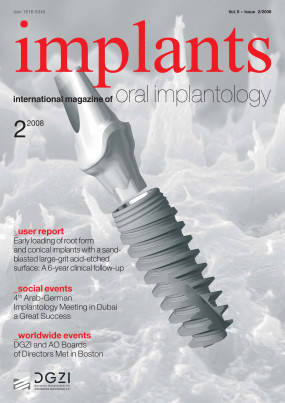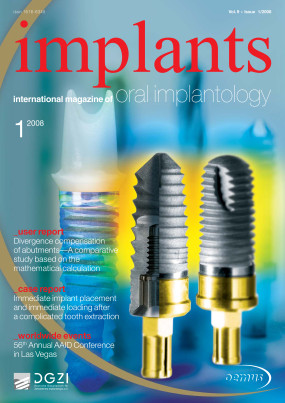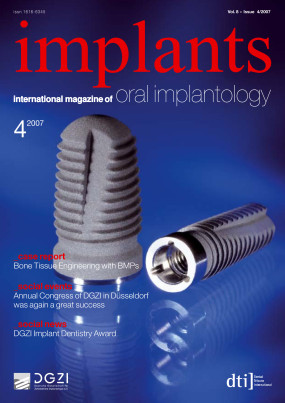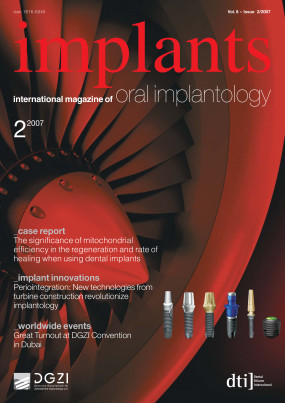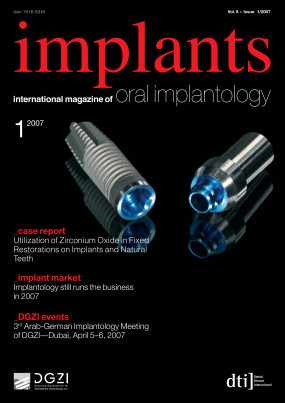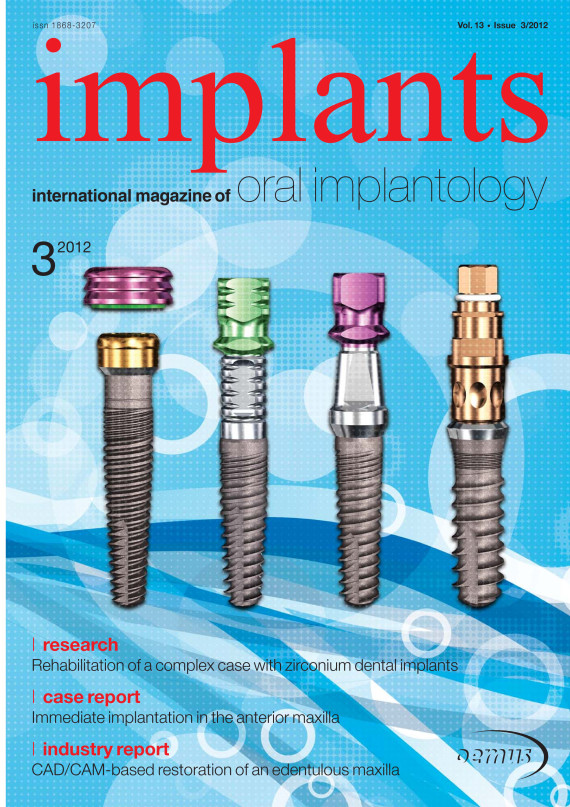Inhaltsverzeichnis
3
Dental implantology has experienced a substantial change in the last 25 years. The treatment spectrum has been significantly expanded; simultaneously, our patients’ expectations and demands in implant treatment have developed disproportionately. In addition, implant dentistry now is also an integral part of everyday dental practice.
6
Rehabilitation of a complex case with zirconium dental implants
Dr Andrea Enrico Borgonovo, Dr Marcello Dolci, Dr Rachele Censi, Dr Oscar Arnaboldi, Dr Virna Vavassori & Prof Carlo Maiorana, Italy
For several decades, dental implants have largely been used for the rehabilitation of completely and partially edentulous ridges with success. For this reason, implant dentistry has been the object of numerous investigations to further improve the effectiveness of this kind of device.1, 2 Titanium is the material most often utilised for dental implants because of its favourable properties, such as its biocompatibility.3, 4 However, aesthetic concerns may arise when restoring anterior teeth owing to the grey colour of this metal...
12
Impression and registration for full-arch implant dentures
Prof Dr Gregory-George Zafiropoulos, Germany
Usually, a full denture is delivered following tooth extraction or implant insertion of a fully edentulous arch. A denture is usually used until the final restoration is performed. A well-designed full denture should fulfill the following criteria: 1) correct vertical height and maxilla-mandibular relationship; 2) accurate occlusion; 3) appropriate choice of teeth with regard to shape, length, width and position; 4) adequate lip support and 5) proper function and aesthetics to meet the patient’s expectations. The final restoration should fulfill or surpass these requirements. Obtaining a correct impression and accurately evaluating the interocclusal relationship (e.g., interocclusal distance, occlusal recording and determination of the exact position of the placed implants) are often challenging and time-consuming tasks.1
20
Time-saving debridment of implants with rotating titanium brushes
Dr Dirk U. Duddeck, Dr Viktor E. Karapetian & Dr Andrea Grandoch, Germany
The mechanical debridement of implants as part of peri-implantitis therapy is time-consuming and tedious. The use of rotating brushes with titanium bristles can result in significantly shortened treatment times. Compared with mechanical curettage, they ensure a gentler and more even treatment of the exposed portions of the thread...
24
Immediate implantation in the anterior maxilla - planning in reverse
Dr Nikolaos Papagiannoulis, Dr Olaf Daum, Dr Eduard Sandberg & Dr Marius Steigmann, Germany
Endodontic and periodontal problems, such as surgical complications, often place before the professional the dilemma of choosing between tooth preservation and extraction. Correctly performed root planing usually leads to soft-tissue recession. In cases of tooth mobility, periodontal surgery can improve the situation only in the short term. Tooth loss eventually follows after some months or years, not to mention the aesthetic disadvantages of flap elevation and tissue excision after periodontal surgical treatment. Similar outcomes are predicted for teeth following endodontic treatment, particularly if they show complications or have undergone root resection. The combination of endodontic and periodontal problems, as with periodontal-endodontic lesions, endangers the tooth, as well as the bone and the anatomy of the jaw. Lesions such as these can result in severe defects, hampering any subsequent treatment with prostheses.1
28
Fixed full arch metal-free prosthesis on four SHORT® implants
Dr Mauro Marincola, Italy, Dr Vincent J. Morgan, USA, Angelo Perpetuini & Stefano Lapucci, Italy
The concept of having only four SHORT® implants for the support of a fixed full arch non-metallic prosthesis (Trinia™), a CAD/CAM fiber reinforced resin, was first executed in 2010. The clinically based results performed in three different implant dentistry centers are showing clinical success because of Trinia’s inherent mechanical and clinical properties. Another factor were the 360 degrees of universal abutment positioning provided by the Implants Locking Taper connection (Bicon®), which gives the opportunity to use the Trinia™ prosthesis to orient and seat the abutments in the well of the implants. The Trinia framework may be covered with either customized poly-ceramic indirect composite material or by conventional denture teeth and resin...
32
There is probably no other treatment method that turns our patients’ quality of life for the better so critically and predictably as the restoration of the edentulous jaw using implantsupported dental replacements (Alfadda et al., 2009). An implant-based, telescopic bridge should be viewed as the treatment of choice for the rehabilitation of an edentulous mandible (Abd El-Dayem et al., 2009). This is the conclusion drawn from the results of an investigation by Eitner and his colleagues in 2008, especially in anatomically difficult situations, in which an implant-supported superstructure guarantees an adequate prosthetic rehabilitation. Visser et al. showed in 2009 that the implant-supported restoration of the edentulous maxilla also represents a proven and effective treatment method with predictable success...
36
Conical internal connections will fuel growth in dental implant market
Dr Kamran Zamanian & Ian van den Dolder, iData Research Inc., Canada
The dental implant and bone graft substitute market is the most rapidly advancing segment of dental technology, and leading competitors in this market must consistently develop new products supported by research from scientific and academic organizations to remain competitive. Recent cases have demonstrated that when companies lose a segment of support from the scientific community, their market shares tend to suffer significantly...
40
Since 2003, IMC Münster at Münster University has offered a master degree entitled "Master of Oral Medicine in Implantology". This Master Degree is internationally accredited by the “Akkreditierungsrat” in accordance with the “Bologna Criteria”. The course consists of a web-based part on the one hand and a high amount of practical training on the other...
41
In 1952, Per-Ingvar Brånemark discovered the principles of osseointegration in Sweden. Thirty years later, in 1982, the discovery was acknowledged and his subsequent findings were confirmed at an epoch-making meeting of dental authorities organized by George Zarb in Canada...
42
44
“Getting to know current practical and, more importantly, practicable ways of long-term success in implantology, that’s what this year’s international annual DGZI Congress is about”, Dr Georg Bach, chair of the board of DGZI (German Society for Dental Implantology) summarizes the congress’ motto ‘Quality-oriented implantology—ways to long-term success’. “Just like in the previous years, we expect up to 500 participants from more than ten countries worldwide”, he adds...









